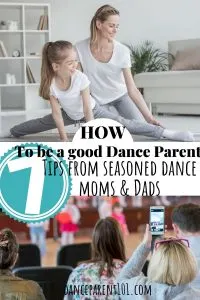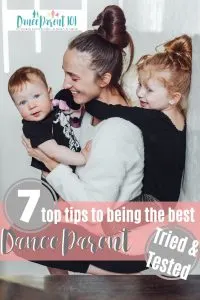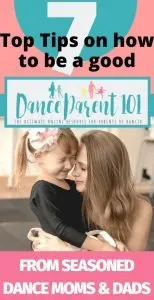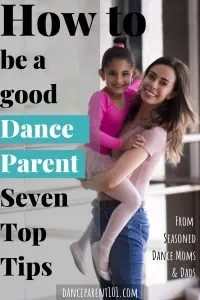
Being a good dance mom or dad might be an intimidating thought to some with good reason. The fact that you are being described as a good parent automatically means that there is a possibility that you could be bad one too.
Infact, I don’t even like the term good or bad dance parent because it implies that the person is bad, I prefer to talk about good and bad behavior because you can choose to make good and bad choices, but you can’t choose who you are.
So why did I even call this article How to be a good dance parent??? Well I used it as my title in all honesty because thats what peeps are searching for! No one is typing into google – How do I act like a decent dance parent or how to have good dance parent etiquette.
You and your dancer can have a successful dance run by keeping the following tips from professionals in mind:
- Do your research on studios
- Follow the policies and dress code
- Trust the process
- Put the work in
- Be encouraging
- Have an Emergency Supply of Dance Accessories
- Realize being a decent dance parent takes time
It may seem like a lot to remember at first, but most of it should come naturally. Take a more in-depth look at each of these tips.
Do Your Research on Studios
Brenda a dance mom of three teenage girls says that the most important thing for her was finding the right dance school. She says “if you’re not already locked into a studio, it pays to do your research.”
Following the rest of the tips to be the best dance mom or dad you can be is a bit trickier if you and your dancer are somewhere neither of you is happy.
The first step is to find out why your child wants to dance. Are they looking to just get some exercise, gain confidence, compete, or just try something new? Different studios have different goals for their dancers just like you.
Dance studios generally fall into two categories: recreational and professional training. Here’s a look at the specifics of each type.
Recreational Dance Studios
A recreational dance studio is the best choice for dancers who just want to take dance for fun. They’ll make new friends and probably even still have a recital and get to perform, but the class requirements won’t be extreme.
Many recreational studios also still have competition teams, which results in a bit more training.
Professional Training Studios
On the other hand, if your dancer eats, sleeps, and dreams dance, you probably want to check out a professional training studio. This is a good choice for dancers who have an eventual goal of performing professionally on stage, either as a dancer or choreographer.
Obviously, because of the higher expectation, the schedule and class requirements are much more rigorous.
Style of Dance
Once you figure out why your child wants to dance, figure out exactly what type of dance they want to do. Two of Brenda’s girls wanted to study ballet, but the youngest was adamant she wanted to learn how to tap as well! Children can do more than one style, but you want to make sure you find a studio that offers that type of dancing.
Take a look at some of the most popular types of dance:
- Ballet
- Jazz
- Contemporary
- Tap
- Hip-hop
- Broadway
- Lyrical
- Ballroom
- Belly Dancing
Most studios offer multiple styles of dance, but for some styles, like ballroom or belly dancing, you will have to find a specific studio.
Brenda’s girls did a trial class at several studios until they found the one they were happiest at. She suggests that once you’ve found a studio you should see if it offers a trial class. Many studios offer trial classes so potential dancers can see if they like the feel of the studio and the teacher and if they are registering for the right level for their ability.
For an in-depth guide, you can read our post on How To Choose The Best Dance School. You’ll have a lot more fun being a good dance mom or dad if you’re at the right studio.
Follow the Policies and Dress Code
Once you figure out which studio you’ll attend, find out the studio policies and dress code. You might find both of these on the studio’s website or posted somewhere in the studio. If you don’t see them, don’t be afraid to ask.
While policies might seem tedious at times, they serve a purpose. Doug, father to Elsie said that as he wasn’t as involved as Elsie’s mom in everything dance, but knowing about the dress code and other policies meant it was easy for him to know what was expected on those days he took Elsie to class. These policies keep the studio running smoothly and allow the instructors to effectively teach their classes.
Policies
These topics are normally included in dance studio policies:
- Tuition and general information on other fees
- Recital, exam and competition dates
- Releases, consent forms, and privacy policies
- Attendance and participation policies
- Dress code, conduct rules, and studio rules
As part of attendance policies, a studio will probably emphasize getting to class on time. It’s a good idea to plan to get to class 15 minutes early. This allows time for any mishaps on the way to class and also gives your dancer time to socialize and warm up.
Studio and conduct rules might include things like not wearing street shoes in the studio and expectations for behavior. It will probably also outline what you can expect to happen if your dancer has any behavior issues in class.
Dress Code
The dress code policy is important because it allows your dancer to train comfortably. Jewelry and certain hair accessories may not be allowed and a uniform might need to be worn and bought. Although dress codes vary from studio to studio, here’s a general idea of what you can expect:
- Leotard or fitted t-shirt
- Tights, leggings, or dance pants
- Proper dance shoes (i.e. tap, ballet, jazz)
When it comes to the dress code, it might be tempting to buy whatever cheap gear you see at the local department store. A good dance parent will quickly learn, though, that it pays to spend a bit more on gear and buy from a company that specifically makes dance wear. Check out our resource guide for some recommended gear if you are not sure what to purchase.
A dress code for all the students or a studio uniform also makes it easier for the instructor to see mistakes and correct them quickly, check posture, technique, and alignment. Finally, your dancer will feel more comfortable if she’s in the same type of gear as the other dancers.
Knowing and following the policies and dress code keeps you out of the doghouse and is definitely a plus when it comes to being a good dance mom.
Trust the Process
Trusting the process is another important tip to being a good dance mom and another reason why you need to do your research and find the best teacher or studio available to you.
When Your Dancer is Upset
Jemma found it hard at first to hear her son James sit in the car and rant about how his teacher had gone on and on about his posture that day in class. She told me “he kept saying, She’s got it in for me, she didn’t say anything like that to anybody else in class!” Jemma said she had to bite her tongue and not join in with his complaints and decided to just sit and listen and give him space to get it all out. By the time they were home James had decided he needed to work on strengthening his core muscles to improve his posture and was on his way to his bedroom to write up a schedule! He also asked his mom to remind him not to slouch whenever she saw that he was!
When it comes to constructive criticism, you have to trust the process. It’s hard for any kid or mom to hear their dancer needs to work on something. Your dancer probably immediately feels like their teacher is the worst ever or that they’ll never be good enough, etc.
They might be upset because they’re in the back row of a dance or they didn’t get a solo during a performance. Maybe they aren’t moving up a level, and a friend is, or maybe they want to be leaping across the stage but are still learning the positions.
Whatever the reason, there will be times your dancer (and you) have to hear that she needs improvement or isn’t ready for something. This is all part of the process. If you have done your research and found an experienced and respected teacher, you need to respect that they know they are doing. Elite dancers don’t just happen overnight, they learn proper technique and form first, and this is most likely what your dancer’s instructor is doing.
A curious dance mom learns to listen to their child and empathize and show their child that they understand how they are feeling. But they don’t add fuel to the fire by agreeing that the dance teacher has it out for them or that everything isn’t fair. Instead, they offer a safe place for their child to vent and get sympathy or whatever it is they need to release to be able to get back on that horse and back into their dance class and do what they love doing best.
Is it too much?
If this criticism happens in every class, it might be time to have a meeting with the instructor. While constructive criticism is helpful, there comes a time when too much becomes destructive. You might want to step in at this point. An attentive dance parent recognizes when their dancer can’t take much more or when a teacher is going too far.
Kids Develop and Learn Differently
The other important thing to remember in the process is that kids all develop differently. A friend in your child’s class might be a natural while it takes a lot more work for your child to perfect the same technique. Your child isn’t doing anything wrong; they just need more time.
When they are busy comparing themselves to friends, an observatn dance parent also reminds their child that although you dance in a group, dance is very individualized. If they are struggling, they should look at themselves after each class and ask, “What can I improve on today?” While they are at it, they can also ask themselves what they did well each day.
If you trust the process, in time, you will see positive results.
Put the Work In
A successful dance career takes work, and it’s your job, as the parent of a dancer to see that your child puts in the right amount of work.
For the Dancer
A dancer may only have class once or twice a week, but that doesn’t mean practice ends there. A dancer can practice their turn out and feet positions while brushing their teeth or check their arm placement in front of the mirror. They can stretch as they read or watch TV or even make it a routine to spend 10mins every day practicing a new skill or doing strengthening exercises.
As the parent, ask your child what they are learning in dance, so they are talking about it at home. It’s also a great idea to ask them to show you their routine. This gives them a chance to practice and you a chance to praise them.
For the Dance Mom or Dad
The work doesn’t stop with your dancer, you’ll have to put in your own work, too, and I’m not just talking about doing hair and makeup.
Terry a dance mom to Reily and Daynor said she found it really important to talk to other moms and dads at the studio and get to know them. She found that other experienced dance parents were a wealth of knowledge and could answer a lot of questions she had. “Plus, you may make friends for life,” she said! She found it amazing how close she has become with some of the dance moms and dads because she made the effort and also because she needs to rely on them to carpool to multiple practices and competitions.
Many studios have fundraisers to raise money for competitions or costumes. An active dance parent volunteers and helps with fundraisers and might even head one up. Studios also always need volunteers to do hair, sew costumes, touch up costumes, make accessories, and help backstage. This is an awesome opportunity for you to step up and help out.
Finally, Terry believes as a dance parent, you need to make sure your dancers are at their best. This means you make sure your children get enough sleep and eats healthy. These things might seem trivial, but she finds good sleep and eating are big factors on how well her dancers practice and perform!
For some more ideas check out our article 14 Things You Can Do Today To Help Your Child Be A Better Dancer. Being a dance mom or dad takes time on both your part and your dancer’s part but will make a big difference not only in their dancing but also within your relationship!
Be Positive and Encouraging
It’s important for dance parents to be positive and encouraging at practice, at performances, and at home.
Encouraging Your Dancer
Simon dad to Kim, David and Bobbi now notice a difference in his kids depending on what he and his wife Layla say to them in regards to their dancing. He found there was a time when they didn’t want to seem like pushy stage parents and so tended to not say much about their kids dancing, resolving that their children were doing it because they enjoyed it and therefore didn’t need any encouragement or motivation from them. But they became really confused when Kim said she wanted to quit because they knew how much she loved dancing. After getting down to the crux of the problem they realized Kim needed to hear words of affirmation and outside motivation from them, as she felt her parents didn’t value what she was doing! As soon as he and his wife took more interest in the kids dance classes and made it a point to give them words of encouragement they noticed not just Kim but all three kids improved more in the next 6 months then they had in the past two years of attending lessons!
If your dancer doesn’t get what they want, whether it’s moving up a level or a solo performance, continue to encourage them. Remind them that eventually, their hard work will pay off, and there are some positives. If they’re on the brink of moving up a level, it means they can set a good example at their current level.
Not getting what they want is also a good opportunity to remind them that the situation is in their hands. You can ask your dancer what they are going to do about it. Are they going to start doing extra practice? Will they ask for extra help from someone more advanced? They have the power to change the situation.
When it comes to recitals, competitions and dance exams don’t just give your dancer praise after the event. Leading up to the performance you have a great opportunity to praise them on how prepared they are and how hard they are working. When you do this, your dancer knows you’re proud no matter how they perform or the result.
A dance parent also encourages confidence in their dancer. Make sure they know the difference between confidence and arrogance, though. Help them be confident they are doing the best they can and not be afraid to try. Not succeeding at something should never mean they stop trying.
Encouraging Other Dancers
Staying positive doesn’t just apply to you and your child; it applies to your attitude toward the other dancers and families as well.
It’s important to not gossip, dramatize or talk negatively about other dancers or parents. A vigilant dance parent also will curb any negative talk or gossip that comes from their dancer as well.
Remind your dancer that she can learn from other dancers whatever their behavior and that they can only control how they themselves react and behave. They should watch other dancers for inspiration. It is a natural human emotion to feel envy or jealousy, but this does not mean it is ok to react to those feelings and treat others or even oneself badly because of them. A tip to break the ice and those feelings is to suggest that your child ask the dancers they admire what they do to achieve their results.
An appreciative dance parent also reminds her dancer to be gracious in receiving compliments and in giving compliments to other dancers. It is okay to say thank you and accept a compliment when someone tells you, you did a good job – it is not necessary to go into all the ways you could have done better as you are rejecting the positivity being brought into your life. Secondly, it is always respectful to pass on the compliments, people always remember how you treat them and being kind is an awesome way to be thought of.
A positive and encouraging dance mom is definitely a big part of what makes a good one.
Have an Emergency Supply of Dance Accessories
Ok so this is an important tip from me and for me to learn from my mistakes! Load up on dance accessories whenever you can! This may seem simple and may sound like it shouldn’t be a requirement, but you’ll soon learn that every organized dance mom or dad has everything they might need on hand, especially in the case of an emergency.
My big mistake was not ordering the right ballet pink shoe paint and waiting until the day before the recital to paint my daughter’s dirty shoes only to realize once the paint had dried, the color it dries to was not right! Luckily in the wee hours of the night I found some cream acrylic paint and mixed it in with the shoe paint to create a ballet pink and not the bright pink her shoes had become. I was just lucky the paint did not crack and fall off. So lesson learned! Be prepared!
Here’s a look at the top accessories you should always have on hand:
- Bobby pins
- Hairnets
- Hair-colored hair-ties
- Hairspray
- Tights
- Shoe paint
You can never have too many of the some of the above items. You’ll go through more bobby pins than you ever imagined you could, especially at recital time or if your child does competitions. Those buns, ponytails, and hair accessories don’t stay in place without a load of bobby pins.
Hairnets are also an essential item to keep all those stray hairs in place and your dancer’s bun nice and tight. Stocking up on hairnets early is always a good idea. They can get holes easily when your child rips them out or they get stuck on hairpins and they can sometimes be difficult to find at the last minute, same with hair-colored hair-ties.
On the hair front, an organized dance mom never has a shortage of hairspray for her daughter or the other dancers. Someone is bound to need some hairspray at a recital and you never quite know when you will reach the end of a can and need a new one, especially right in the middle of preparing for a performance.
Always have a few pairs of backup tights on hand! You never know when your dancer is going to snag a leg or get a hole and need a new pair and you don’t want to be about to send them on stage or into an exam when this happens without a backup. No one wants to show up to dance with a run in their tights or no tights at all.
Finally, having a bottle of shoe paint in the colors of your child’s dance shoes especially ballet pink and beige can be a lifesaver. It’s not as if you have a special pair of shoes just for classes and rehearsals and a pair just for performing, therefore your child’s shoes might be scuffed or have black marks around the toes which can only be covered with paint as scrubbing them just usually makes the marks spread!
You’ll be THE MOM or THE DAD if you’re the one that always has what people need on hand.
Realize Learning to be a Dance Parent Takes Time
With all of the above covered, it’s important to realize that learning everything it takes to be a dance parent. You can cover all of the above and still have your child show up with the worst hair and makeup at a recital and feel like a total failure because that’s just life!
The title, “Awesome dance parent,” comes with time and practice and seriously everyone’s guide to what a good or successful dance parent is will look different. So for example, unless you are a professional make up artist it might take a few performances to get the makeup application just right on your child. I danced all my life and thought I knew everything about dance makeup, but it wasn’t until the studio photos came out that I realized my daughter’s face looked orange compared to everyone else! Her skin is darker olive than mine and I had used a darker foundation on her as I thought this would help because of the harsh lighting on stage, but no… she just looked well like a pumpkin really – a really really cute pumpkin of course, but still a pumpkin!
Use the Danceparent101.com website!!!
Don’t be afraid to search the Internet for tips on everything you need to know – hopefully, we have most of the information here on Danceparent1-1.com and if not comment below with what else you would like to see on our site!
Do a search in our search bar on the top right and see if we have what you are after!
And Finally…
Respect to you for wanting to be the best dance parent. It’s worth it for both you and your child. Keep the above tips in mind, and you’ll earn the title in no time!






Leave a comment
You must be logged in to post a comment.